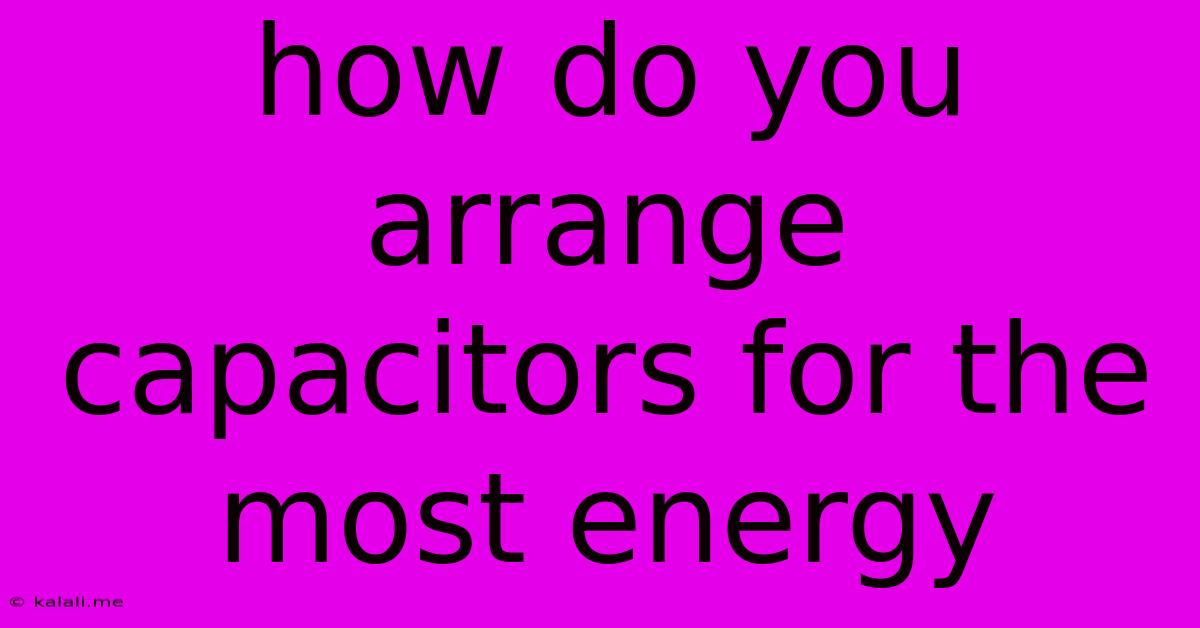How Do You Arrange Capacitors For The Most Energy
Kalali
Jun 03, 2025 · 3 min read

Table of Contents
How to Arrange Capacitors for Maximum Energy Storage
Capacitors are passive electronic components that store electrical energy in an electric field. Understanding how to arrange capacitors for maximum energy storage is crucial in various applications, from power supplies to energy harvesting systems. This article explores different capacitor arrangements and their impact on overall energy storage capacity. We'll delve into series and parallel configurations, examining their advantages and disadvantages to help you optimize your energy storage needs.
Understanding Capacitance and Energy Storage
Before diving into different arrangements, let's revisit the fundamentals. The energy stored (E) in a capacitor is directly proportional to the capacitance (C) and the square of the voltage (V) across it:
E = ½CV²
This equation highlights that increasing either capacitance or voltage will increase the stored energy. The capacitance itself depends on the capacitor's physical characteristics: the dielectric material, plate area, and separation distance. However, we can manipulate the effective capacitance of a system by connecting multiple capacitors together.
Series Capacitor Arrangement
In a series arrangement, capacitors are connected end-to-end. The total capacitance (C<sub>total</sub>) is less than the smallest individual capacitance. The formula for calculating the total capacitance in a series circuit is:
1/C<sub>total</sub> = 1/C₁ + 1/C₂ + 1/C₃ + ...
Advantages of Series Connection:
- Increased Voltage Rating: The key advantage of a series connection is that it allows for a higher voltage rating for the entire system. Each capacitor shares the total applied voltage, reducing the stress on any single capacitor. This is crucial when dealing with high-voltage applications.
Disadvantages of Series Connection:
- Reduced Total Capacitance: As mentioned, the total capacitance is significantly reduced. This directly impacts the amount of energy that can be stored at a given voltage.
- Voltage Distribution Issues: If the capacitors have slightly different capacitances, the voltage across each capacitor will not be perfectly equal. This can lead to unequal stress and potential failure of some capacitors.
Parallel Capacitor Arrangement
In a parallel arrangement, capacitors are connected across each other. The total capacitance (C<sub>total</sub>) is simply the sum of the individual capacitances:
C<sub>total</sub> = C₁ + C₂ + C₃ + ...
Advantages of Parallel Connection:
- Increased Total Capacitance: The parallel arrangement offers the greatest advantage: a significant increase in total capacitance, leading to a substantial increase in energy storage capacity at a given voltage.
- Equal Voltage Distribution: Each capacitor experiences the same voltage, ensuring equal stress distribution.
Disadvantages of Parallel Connection:
- Increased Current Draw: The parallel arrangement will draw more current, potentially placing a greater load on the power source.
- Space and Cost Considerations: Requires more physical space and potentially higher cost due to the increased number of capacitors.
Optimizing Capacitor Arrangements for Maximum Energy Storage
For maximum energy storage, a parallel arrangement is generally preferred. This is because the total capacitance increases directly with the number of capacitors. However, the voltage rating of the individual capacitors must be considered. If the available voltage exceeds the rating of a single capacitor, a series-parallel combination might be necessary to distribute the voltage while maintaining a high total capacitance. Careful calculation and consideration of individual capacitor specifications are critical for optimal design. Remember that the energy stored is also proportional to the square of the voltage – a higher voltage will always result in higher energy storage, provided it remains within the safe operating limits of the system.
Conclusion:
Choosing between series and parallel capacitor arrangements depends entirely on the specific application requirements. While series arrangements are beneficial for high-voltage situations, parallel arrangements are superior for maximizing energy storage capacity. A thorough understanding of both configurations and the interplay between capacitance and voltage is essential for designing effective energy storage solutions. Always prioritize safety and ensure the chosen arrangement stays within the voltage and current ratings of the individual capacitors.
Latest Posts
Latest Posts
-
Deploy Apps From Android And Iphone Best
Jun 05, 2025
-
What Does Jss Mean On Walking Dead
Jun 05, 2025
-
How To Wire A Humidifier To A Furnace
Jun 05, 2025
-
Can You Be Charged With Trespassing After The Fact
Jun 05, 2025
-
How To Know If A Coconut Is Bad
Jun 05, 2025
Related Post
Thank you for visiting our website which covers about How Do You Arrange Capacitors For The Most Energy . We hope the information provided has been useful to you. Feel free to contact us if you have any questions or need further assistance. See you next time and don't miss to bookmark.